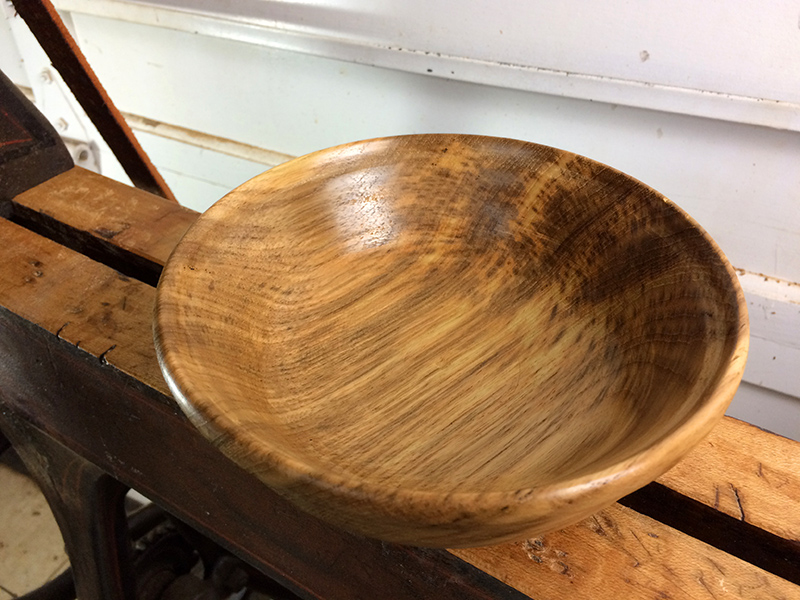Faster than a Speeding Bowl
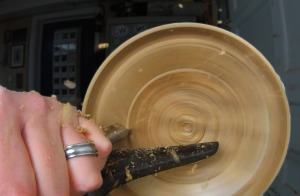 Once you get labelled a “woodworker” by your circle of friends, colleagues, acquaintances, etc you often get asked (at the last minute) to create gifts for birthdays, retirements, or colonoscopy appointments. So it was natural when a colleague of mine at the lumber yard retired that I found myself at the lathe pedaling away and making a Teak bowl.
Once you get labelled a “woodworker” by your circle of friends, colleagues, acquaintances, etc you often get asked (at the last minute) to create gifts for birthdays, retirements, or colonoscopy appointments. So it was natural when a colleague of mine at the lumber yard retired that I found myself at the lathe pedaling away and making a Teak bowl.
I’m not a prolific bowl maker but I do enjoy face plate work from time to time. This was actually my first opportunity to do a bowl on my new Barnes No 3 lathe so I was anxious to see how she performed. And because I’m always looking to try new techniques I decided to do something different during the turning. It ended up being one of those “learning experiences” that are usually accompanied by colorful language and forced timeout in the corner to think about what you have done. But in the end this bowl illustrated the required skill for all woodworkers: the ability to shake it off and fix a mistake without chucking the whole project and starting over.
Let’s Start From the Beginning
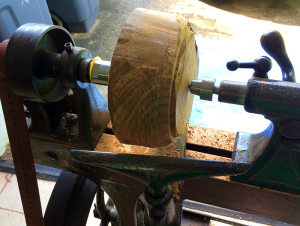 I used my bowsaw to cut out a round-ish blank from a 12/4×9 hunk of Teak and mounted it on the lathe with a faceplate and screws to begin truing it. The mass of the Barnes handled the extra vibration nicely of an eccentrically turning large blank. Moreover I got no belt slippage at all as I was turning that outermost edge where the leverage is high as is the velocity. This was a concern going into the project and the Barnes didn’t let me down.
I used my bowsaw to cut out a round-ish blank from a 12/4×9 hunk of Teak and mounted it on the lathe with a faceplate and screws to begin truing it. The mass of the Barnes handled the extra vibration nicely of an eccentrically turning large blank. Moreover I got no belt slippage at all as I was turning that outermost edge where the leverage is high as is the velocity. This was a concern going into the project and the Barnes didn’t let me down.
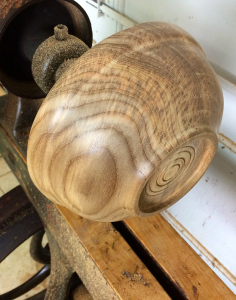 Once round I began to shape outside of the bowl. I was shooting for a deeper fruit bowl shape and this is where I deviated from my usual approach. Instead of creating a tenon for the chuck to hold the bowl while hollowing, I turned a dovetailed recess. This way I would expand the chuck into the recess and the end result would be hidden and tucked up inside the “foot” of the bowl in the finished product. It made for a cool line to the bowl with a fast S curve tucked in at the bottom. I even added a few decorative details for fun that also act as lines to write an inscription upon later. I then went to work sanding and polishing the outside before flipping around to begin the hollowing.
Once round I began to shape outside of the bowl. I was shooting for a deeper fruit bowl shape and this is where I deviated from my usual approach. Instead of creating a tenon for the chuck to hold the bowl while hollowing, I turned a dovetailed recess. This way I would expand the chuck into the recess and the end result would be hidden and tucked up inside the “foot” of the bowl in the finished product. It made for a cool line to the bowl with a fast S curve tucked in at the bottom. I even added a few decorative details for fun that also act as lines to write an inscription upon later. I then went to work sanding and polishing the outside before flipping around to begin the hollowing.
With the bowl flipped around I expanded the dovetail jaws of the chuck into the recess and got a perfect fit on the angle and a secure hold. My chuck jaws were taller than the recess so I was a little concerned that I couldn’t fit the shoulder of the recess tight up against the chuck like I usually do. Still the hold was solid so I went to work with the bowl gouge.
Cut to about 30 seconds later
…and with a sickening crap the recess cracked off and the bowl went flying. Right into my faceplate actually. Wear your safety gear kids! Even this foot powered lathe can turn things at over 1500 rpms.
“Good golly Miss Molly and sugar beets!”**
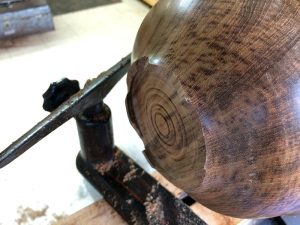 I said loud enough for the mother walking her child across the street from my open garage, to turn and quickly herd her child the other direction.
I said loud enough for the mother walking her child across the street from my open garage, to turn and quickly herd her child the other direction.
**this is not what I actually said, but rather an expletive often heard from my wife who spends her days teaching 5th grade girls
It is always frustrating when a screw up ruins work you have already done, but when that work was done by furiously pedaling a lathe on a hot and humid day, it stings just a bit more. And so after feeling sorry for myself, eating a sandwich to replenish my lost calories, and getting a pep talk from my puppy, Kenny, I was back at the lathe with the broken bowl mounted once again to a face plate to assess the damage.
This is one thing about woodturning that is liberating, it is so easy to reshape something on a whim. And when the whim becomes necessity this flexibility can save a project. With a deadline looming I was hesitant to try this recess method again so I grabbed a parting tool and quickly made a dovetailed tenon. Then I just have to reshape the curve of the bowl to eliminate the flat and hopefully end up with a pleasing form again. After a few minutes more of pedaling I was happy with my somewhat squatter yet still fruit bowl like shape.
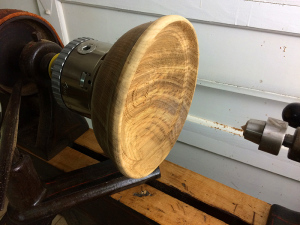 With a little clean up on the outside, I was chucked up and ready to start hollowing once again. This time I lasted more than 30 seconds and was able to hollow the bowl to completion without incident. In the end I was happy with the overall shape and I think the bowl looks lighter and flatter event though it still have the original depth I was going for. It funny how a dramatic change still yields the same functional space.
With a little clean up on the outside, I was chucked up and ready to start hollowing once again. This time I lasted more than 30 seconds and was able to hollow the bowl to completion without incident. In the end I was happy with the overall shape and I think the bowl looks lighter and flatter event though it still have the original depth I was going for. It funny how a dramatic change still yields the same functional space.
So What Did I Learn?
No lesson will ever be learned unless some reflection of the incident is done. At first I figured I had just turned the recess wall too thin an exerted too much pressure from the jaws of the chuck. It was through sharing my disaster pictures online that I was given the head slappingly obvious advice that I should have matched my chuck jaws to the radius of the recess. Thanks Shawn After all, I’m always seeing incredibly thin walled bowls coming out of the shops of people who actually know what they are doing.
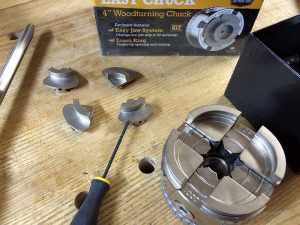 Y’see by using jaws with a tighter curve I wasn’t pressing out equally on the walls of the recess but rather concentrating the force in 3 or 4 small points which was bound to fail. This fact was strengthened the next day when I found a perfectly intact dovetailed wall that had been snapped off between two pressure points. I started to realize why lath chuck manufacturers make so many different accessory jaws. Of course I’m even more upset with myself because thanks to the generosity of Easy Wood Tools I happen to have several different jaws that are stupid easy to snap in and out in seconds with their Easy Chuck (excuse the impromptu commercial). Had I matched the radius I would have been able to keep my thin walled recess and evenly distribute the force of the chuck around the bowl and not turned my bowl into a missile. More likely, I would have turned the radius of the recess to match the jaws that I have.
Y’see by using jaws with a tighter curve I wasn’t pressing out equally on the walls of the recess but rather concentrating the force in 3 or 4 small points which was bound to fail. This fact was strengthened the next day when I found a perfectly intact dovetailed wall that had been snapped off between two pressure points. I started to realize why lath chuck manufacturers make so many different accessory jaws. Of course I’m even more upset with myself because thanks to the generosity of Easy Wood Tools I happen to have several different jaws that are stupid easy to snap in and out in seconds with their Easy Chuck (excuse the impromptu commercial). Had I matched the radius I would have been able to keep my thin walled recess and evenly distribute the force of the chuck around the bowl and not turned my bowl into a missile. More likely, I would have turned the radius of the recess to match the jaws that I have.
In hindsight its pretty obvious and I think I’ve been lucky up until now using my tenon method that I haven’t messed up the tenons with unsightly pinch points. I guess I’m even happier now that I have a chuck that makes switching the jaws in and out so quick…now I just have to remember to do it.
But with any project, it is the end result that matters. I like the bowl and more importantly the recipient of this retirement gift was very happy.
